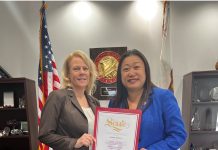Preservation Heroes

Local retired firefighter Eugene “Diz” D’Isabella is famous for his devotion to the 1931 Seagrave Suburbanite, the antique fire engine he drives in the Patriot’s Day Parade.
He brought it to a South Laguna Community Garden potluck a few years ago, patiently spending his afternoon with kids fascinated with the truck from another era. He served in the Laguna Beach Fire Department for years, fought the 1993 firestorm and once saved the fire chief’s life by administering CPR. “I could have retired at 50, but I worked until I was 70, I loved my job so much. They were the heroes. “People were always so grateful to see us,” he explained last week when I visited his home, of similar vintage to the Seagrave.
Diz has been making regular appearances at heritage committee meetings trying to get answers about the historic status of his home, rated “K” for key on the city’s historic inventory. The questions he raises are valid ones and I hope I helped to answer some of them. This column includes some of those answers as well as additional thoughts about historic preservation in our town.
The history of Laguna Beach is an integral part of its charm and its persistent memorable images. The story of how our community came to be is not only what we market to the world, but it is what makes us so comfortable and delighted to be here. Carrying on the artistic, environmentally caring traditions makes us feel our place in the unique story that is Laguna Beach. History is not best experienced by reading books and looking at old photos, it is felt deeply by being here, being part of the continuing lives that march through the artifacts of time.
Those artifacts are historical resources, buildings and properties, and saving them while providing enjoyment and livability for their occupants and owners has been the focus of the city’s heritage committee for years. Their work for the past 18 months has involved the public intensively in efforts to improve our historic preservation program.
The staff and the committee offered monthly workshops on all the topics related to historic preservation, including the historic register, the inventory of historic resources, and the interface of the local program with the California Environmental Quality Act (CEQA).
It seems complicated, but it is surprisingly simple too. There are national and state programs for historic preservation, and in 1981 Laguna Beach undertook an inventory of historic resources under state guidelines. This inventory and a historic preservation element and ordinance were adopted in the 1980s. Participation in the preservation program was voluntary, but incentives were granted to property owners who committed to preserve their historic properties and put them on the register.
Then in 1991 the state added historic and cultural resources to the list of items to consider when evaluating a project under CEQA. That means that demolition or significant changes to a historic resource must be considered a potential environmental impact and evaluated accordingly. CEQA is a required process. However, it doesn’t dictate conclusions. It does require alternatives to be considered and evaluated before the requested permits are granted.
It wasn’t until 2005 that the city started applying CEQA to historic resources. Here is where property owners like Diz, who thought historic preservation was voluntary, faced the prospect of additional review and they raised concerns.
It was more than five years later that there was an acknowledgement that there were historic resources that were missed in the 1981 inventory. On the inventory or not, if a property is historic it is subject to CEQA evaluation. Understandably owners of properties not on the inventory were frustrated to find historic criteria being imposed on buildings they did not know were considered historic.
Now the city is finding ways to apply the rules and procedures that should have been in place since the 1991 change in the California Environmental Quality Act.
So this is the situation the heritage committee has been sorting out in the new ordinance with public input and addressing the concerns that have surfaced.
The new ordinance clarifies the process for review, provides for an early determination of historic status, specifies disclosures in real estate transactions, and provides for a style guide that explains the characteristics of historic buildings and gives guidelines for making additions and changes. The committee stressed that owners of historic properties should be given hero’s treatment at city hall, and provided with all the incentives available. The committee has repeatedly emphasized that there are many possibilities for enhancing and adding to historic buildings while preserving their character-defining features.
The testimony at the heritage committee hearings was dramatic, some property owners, including Diz, feared that their property values were diminished by being considered historic. One man complained that the house he had just inherited would be difficult to sell because of the historic designation. Shortly after his testimony the property was listed and it sold for more than the asking price. The buyers were ecstatic that they had found a historic property. By preserving it under the historic preservation ordinance they were able to apply for the Mills Act, saving significantly on property taxes.
None of our properties are “generic” lots; each one of them has distinguishing features, both favorable and limiting. Views or not, geologic stability, water courses, slopes, access, and history is part of this menu too. Addressing it systematically, with sensitivity and a positive approach will result in preserving our community’s historical resources and at the same time provide residents with the distinctive and comfortable living environments that historical properties offer.
The heritage committee, staff, and property owners who participate in this process are our preservation heroes.
The author is a landscape architect and former council member.




